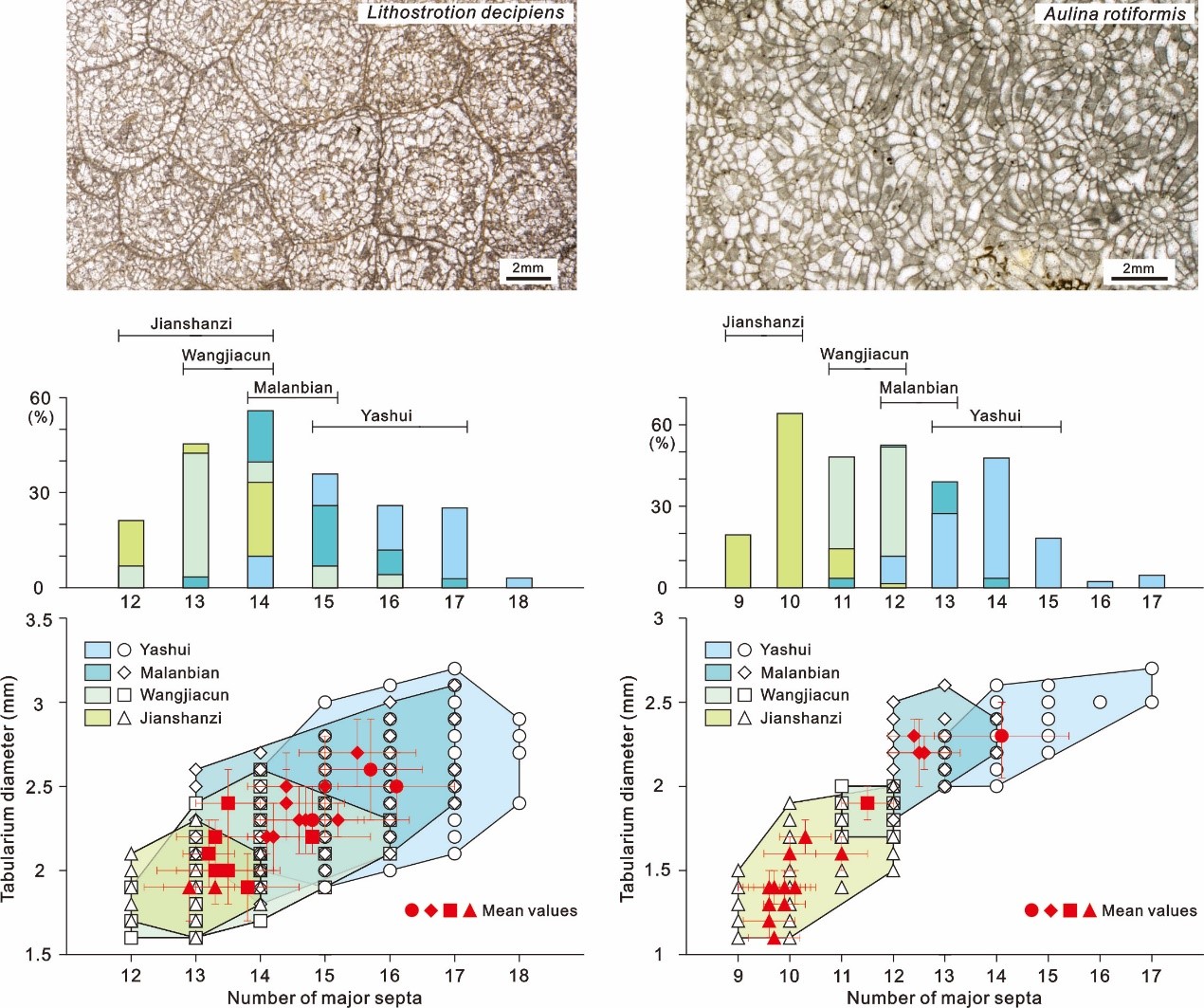
Enhanced terrestrial input brings severe influence on coral reefs, accompanied with coral death and morphologic variation. Similar scenarios could be suspected for geological times, but how reef corals reacted to terrestrial input remains unclear.
Recently, researchers systematically documented the morphologic variation of reef corals and terrestrial sediment input during the Middle-Late Mississippian, and uncovered the relationship between size changes in reef corals and terrestrial input during the onset of the late Palaeozoic Ice Age (LPIA).
The study was published in Proceedings of the Royal Society B on May 24. It was conducted by Assoc. Profs. YAO Le and LIN Wei from the Nanjing Institute of Geology and Palaeontology of the Chinese Academy of Sciences (NIGPAS), in collaboration with Prof. Markus Aretz from the University of Toulouse III, Prof. David J. Bottjer from the University of Southern California, and Prof. WANG Xiangdong from the Nanjing University.
LPIA is the only period containing similar atmospheric CO2 concentration to modern times, since the evolution and proliferation of animals and plants. During the Middle-Late Mississippian (late Visean to Serpukhovian stages), prominent Hercynian orogeny and terrestrial plant proliferation led to enhanced terrestrial silicate weathering, sediment and nutrient input, which resulted in a dramatic climate cooling and sea-level fall.
Recent studies uncovered that an obvious positive shift in brachiopod oxygen isotope occurred across the Asbian-Brigantian boundary (late Visean), indicating the drop in sea-surface temperature and the onset of the major phase of the LPIA. During this time, the marine coral reef ecosystems collapsed associated with distinct decline in benthic fauna diversity. Hence, studies on the size variation in the Middle-Late Mississippian reef corals could provide the evolutionary trend of modern marine reef corals under increasing influence from terrestrial sediment influx.
In this study, the researchers tested the impact of enhanced terrestrial runoff on size (corallite/tabularium diameter and septal number) variations of the Serpukhovian colonial corals Aulina rotiformis and Lithostrotion decipiens from the Yashui, Malanbian, Wangjiawan and Jianshanzi sections, which develop along a gradient of open marine carbonate to near-shore siliciclastic facies in South China. They also conducted elemental mapping for reef corals and their surrounding rocks.
"Along this gradient, their sizes decreased from carbonate, through intermediate carbonate-siliciclastic, to siliciclastic facies," said YAO. "While this is consistent with increasing abundance of terrestrial materials of high silicon, aluminium and phosphorus values." On a larger million-year-long interval and for several palaeocontinents, size data of Lithostrotion decipiens and Siphonodendron pauciradiale showed a distinct decline across the Asbian-Brigantian boundary in the late Visean, when enhanced terrestrial weathering and sediment input occurred during the LPIA onset.
This study reveals the spatial-temporal evolutionary trend of reef coral size and terrestrial sediment input. It suggests that terrestrial sediment and nutrient input may have mainly controlled phenotypic plasticity in Mississippian reef corals, with a decrease in size as a component of resilience across the LPIA onset.
In addition, these findings can provide insights into the long-term evolution and regulation of modern marine coral reefs as corals containing the ability to decrease in size are more resilient under high sedimentation from terrestrial runoff.


Fig. 2 Thin-section photographs (a–c) and their corresponding elemental–mapping photographs (d–o) of the colonial coral species Lithostrotion decipiens in the Yashui, Malanbian and Wangjiacun sections from left to right sequentially. (Image by NIGPAS)

86-10-68597521 (day)
86-10-68597289 (night)

52 Sanlihe Rd., Xicheng District,
Beijing, China (100864)

